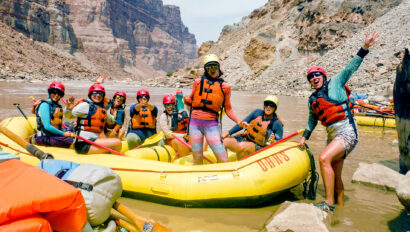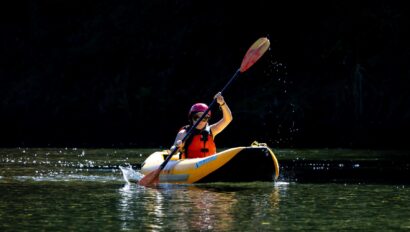10 Things I Wish I Knew as a Beginner Trout Angler

Learning how to fly fish for trout can be intimidating, to say the least. When I started fly fishing, it felt like I would never get a handle on all the lingo, best practices, and techniques. Even as a guide, I’m still learning. This is part of the fun – there’s always a way to improve! There are also some universal beginner fly fishing tips that, whether I’m guiding or answering questions on my Instagram page, I always emphasize.
How to Fly Fish: A Professional Guide Shares Her Best Advice for Newbies

1) The Equipment Basics
Walking into a fly shop for the first time or browsing an online store to find your first trout fishing set up can feel like an unsolvable math equation. Fishing can be endlessly complex (in a fun way!) but the basics are also pretty, well, basic.
Rods are sold in length, and weight of line (I like a 9-foot-long, 4-weight rod for trout fishing). The fly line (colored plastic) matches the rod weight (buy a 4-weight line for a 4-weight rod).
Reels are typically sold in a range and again, will indicate a weight (3 – 5 weight). Then, all you need is a leader (the clear part – I like a 9 foot, 3x or 4x leader generally).
Tippet (also clear – what you add to a leader as you snip it back) and leaders are sold by thickness, with 0x being the thickest and 6x being thinner.
Backing is a string-like-line that goes on the reel first. Fly shop employees are there to help you decipher all this.
Don’t be afraid to bring the staff your rod and reel, or simply ask them to help you build a set up from scratch. Also, I avoid trying to put a new fly line on a reel by myself. Both manufacturers and most fly shops have a handy tool to do this that’s way faster and less frustrating than a home attempt (yes, I’ve tried).

2) Read the Fishing Report
Most area fly shops will publish online fishing reports detailing what the fish have been snacking on that week. You don’t need to have every fly ever made in your fishing pack, just the flies relevant to that moment. Eventually, you’ll build up a library of flies that will keep you fishing all season long.
3) Go to YouTube Trout University
There are many different fly fishing instruction videos for free on YouTube, particularly as you learn knots or fly tying. Two great beginner knots are the improved clinch knot (for tying on your fly) and the surgeon’s knot (for adding tippet). Practicing at home can make sure you tie correctly when you’re out on the river.
4) Bad Days are Normal
Part of learning how to fish is looping your line, losing flies, and botching knots. When it comes to tangles, unwinding a messy one can be a meditative, riverside practice. Other times, you’ve just got to cut the whole thing off and start over. If the type of fishing allows it, moving to a larger tippet size (4x or 3x instead of 5x or 6x) can help avoid frustrating tangles. There are also days where, try as you might, you won’t catch a single fish. This is a normal part of fishing. Even the experts get skunked! Enjoy being out on the water and in nature regardless.

5) Casting Doesn’t Matter
…at least not as much as you think. Casting might be the most visible part of fly fishing and it undoubtedly helps to have an accurate cast, but it’s not the only part of fishing that matters. Especially if you are trout fishing out of a boat, often what your line does on the water is more important than how it looks over your head. A basic cast is more than enough to get you started for a great day of angling. As important as casting is learning where trout are holding in a waterway.
6) Think Like a Bug
When it comes to how to drift your fly on the surface of the water, you’re going to hear a lot of fancy vocabulary like mend and strip. What you’re trying to do with a fly is mimic an insect (dry flies) or small fish (streamer) in a way that looks natural. Spend some time watching aquatic insects (mayflies, stoneflies, and caddis) on the surface of the water. Then mimic that drift, while also keeping enough tension in your line to set the hook when a fish eats.
7) Find Your Fishin’ People
Initially, as a queer woman, I didn’t really see myself represented in fly fishing. Luckily, that is starting to change. Affinity groups can be a great place to learn the basics and meet fishing partners. United Women on the Fly, Brown Folks Fishing, and Queers and Camo are great places to start. Many local fly shops will also know of groups offering workshops and other community building gatherings.

8) Conservation is Key
Part of being a trout angler is taking care of the places you fish. From trash clean up days to lobbying your state or federal policy makers for river protections, there are a multitude of ways to give back. As an individual, catch and release fishing only works if the fish survive the release! During warm times of the year, restrict your trout fishing to when water temperatures are below 64 – 68˚F (depending on type of trout), fishing a barbless hook, and fighting and releasing fish quickly help keep trout populations healthy.
Also, remember that Indigenous people are the original stewards of many trout fishing areas in the U.S. and Canada. If an Indigenous person is fishing in a different way than you, they likely have rights to that method of take. Additionally, many areas allow a limited harvest of trout for anyone with a fishing license. Folks (myself included at times!) fish to eat, and do so legally.

9) Fish with an Expert
A guided fishing trip, or even hiring a fishing guide for a day on your local stream, can be a great way to get to know a waterway. If you can’t afford a guide, it never hurts to give a call anyway. Sometimes guides will fill last-minute spots at a discount, or offer group workshops at a lower cost.
10) Be a Lifetime Learner
Fishing is a truly lifetime sport. Stay curious and enjoy the endless learning opportunities of catching trout!
Photos courtesy of Emerald LaFortune
Related Posts
Sign up for Our Newsletter





